This post follows Red Centre holiday: overview.
To cross the Simpson Desert you need a pass which cost us $150 per vehicle. I understand that about 15 vehicles a day* do the trip, so it is not an entirely exceptional thing to do. However, it is not routine either and requires careful planning.
Before we left we understood that there were three main tracks – the French Line, the WAA Line and the Rig Road. In practice there is a network of tracks linking all three, as you can see from this map (scroll down). The French line is the shortest, most direct route, basically one sandhill after another and is said to be the most challenging. West to east is easier because the prevailing winds that formed the sandhills blow from the west making the eastern sides steeper. The French Line is said to have less variety in landscapes.
The Rig Road was made as a mining access road during an unsuccessful mining exploration phase. It travels a fair bit north-south, crossing the dunes further south where they are lower.
We made it up as we went, using the the French Line, the Rig Road, the WAA Line near where the Colson Track comes down from the north, the Erabena Track to pick up a side trip to the Lone Gum (a lone coolabah tree in a treeless landscape), the Rig Road again to Knolls Track, and north along Knolls Track to the French Line. From there the options cease. You head east to Poeppel Corner, north to the QAA line and then on to the last and largest dune Nappanerica (commonly known as Big Red), and thence to Birdsville.
Our odometer, which according to other checks we made on the distance between towns was fairly accurate, showed 581 kilometres from Mt Dare to Birdsville. We took five days and after a longish first day when we got into the desert proper 100km per day was the norm with a speed across the ground of about 20kph. The pattern was to leave about 9 am (sunrise was 7.25 am) travel until 4 pm stopping once for smoko, for lunch and for photo opportunities. From 4 pm we looked for a camping spot. Then it was setting up camp, beer o’clock, chatting around the fire (most nights), dinner preparation, eating and chatting around the fire, washing up and then to bed by 10 pm at the latest.
We used 98 litres of fuel or about 17 litres/100km. Depending on whether normal was 12 or 13 litre/100km that makes our fuel consumption 30 to 40% higher than normal. We’d been told to expect up to double. We took five extra 20 litre cans plus 75 litres in the tank, so had 175 litres in all.
You have to plan for the contingency of being stuck in the desert, so extra food is a necessary precaution. After the desert crossing we fed for four more days on our supplies, only purchasing a loaf of bread in Windorah and still had food to contribute to Geoff’s larder on returning to Emerald.
On the second day after leaving Purnie Bore we came upon a poor bloke who had done a front wheel bearing and was camping with his vehicle while help came from Mt Dare:
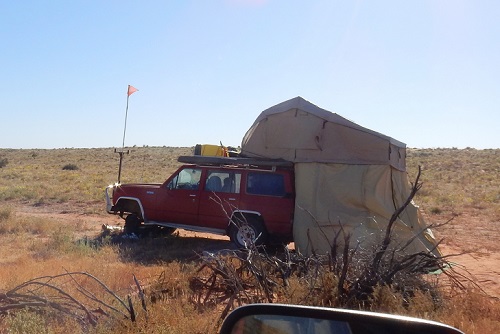
We took about 80 litres of water. Our first glitch occurred almost immediately after leaving Mt Dare, when Darral behind us noticed that we were leaking water. Here we are investigating:
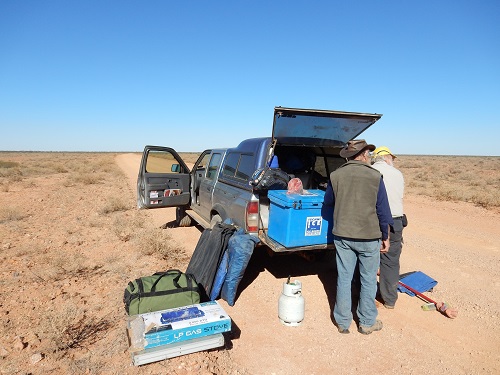
We found that a tap at the bottom of a 30-litre container had turned itself on, so we lost about 17 litres. Securing the tap with gaffer tape ensured that the horrendous corrugations could not wreak any further havoc. We were careful with water after that and used perhaps half of our remaining supplies, or about 2 litres per person per day for drinking, cooking and washing up. We used wipes to clean ourselves as necessary. Air temperature would have a major influence on water usage. In August we experienced temperatures from low single figures up to low to mid 20s.
The Hema guide says:
While in the desert, self-sufficiency is essential. Carry at least seven litres of water per person per day, and emergency food and water for another 7 days. Keep track of your fuel consumption too, taking into account that driving in soft sand increases fuel use by around 50% in diesel vehicles and can almost double it in petrol vehicles.
Two days into the desert on the third morning we had a narrow escape, rescued by amazing good fortune. I had severe doubts about our 1999 Nissan Navara which we initially called “The Beast”, but recall saying to Len during the second day that I had no worries about the engine, which purred along smoothly. I was more worried about breaking a spring as we pitched and lurched with a significant load. All that changed when the engine would not run when we started up next morning.
The consensus was that it was probably a blocked fuel filter, which proved correct when we took it out of the line and bypassed it. Then as if by magic, Erik appeared, and took charge. That’s him in the middle:
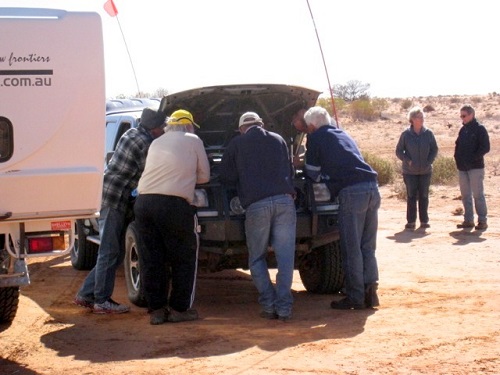
Erik was a farmer from Quirindi, who seemed to know all about engines. What’s more, he had two spare in-line filters in his truck, and was happy to give us one. Certainly it was a Toyota part and we had a Nissan but it fitted and would see us through to Birdsville. Later in Birdsville Len had the proper part fitted for $45.
In preparation, people tend to worry about tyres and radiator hoses. We carried an extra tyre and tube in addition to the spare wheel. None of the Famous Five had any such problems on this trip, but I’d say none will venture again into a desert without a spare fuel filter.
We immediately started a campaign of Erik for president! He said he was cool with that but would always tell the truth, which could be a problem! Erik declined to accept any cash for the filter, preferring instead to have it replaced once we returned home. Len was surprised to find that the genuine Prado part was a cool $100! So Erik has a new one and his kind donation in our hour of great need is being mounted for display as a memento of our Simpson adventure!
Len says he was still in decision making mode when Erik arrived. Bypassing the filter confirmed the diagnosis, but clearly it is dangerous to run the motor like that. Without a filter, dirt in the injectors could result in an even more serious breakdown. Without Erik’s intervention the ‘correct’ decision was probably to stay put and try to get a filter from Mt Dare.
This raises the issue of what happens if a vehicle has to be retrieved, which they must be. There are no wrecks left in the Simpson Desert. At the Birdsville roadhouse Len was introduced to “The Monster” used in desert retrievals. It can carry a 4WD on its back.
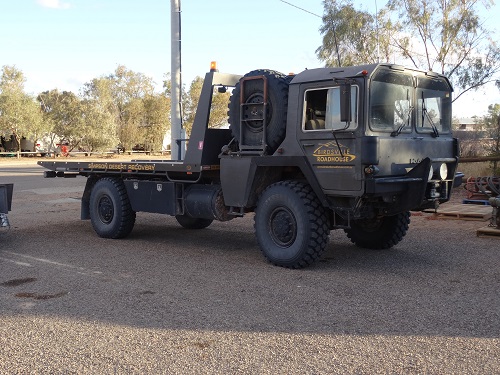
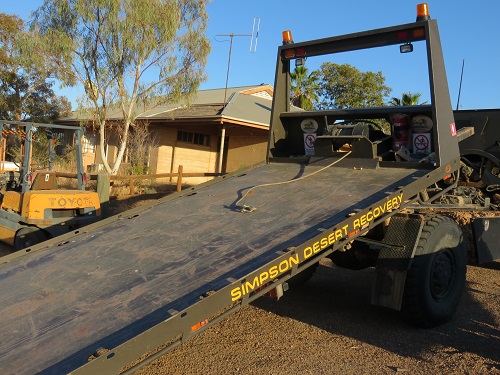
Most people I ask guess the hourly rate charged as $200 per hour. Actually it’s twice that – $400. A retrieval could involve 10 hours or more driving to the stricken vehicle plus another 10 hours back. The owners of the Mt Dare Hotel on the western edge of the desert offer a similar vehicle recovery service …. for the unwary, or maybe just unlucky!
After that hickup “The Beast” performed beautifully on the sandhills. I warmed to it and proposed that we rename it “Bessie”.
Bessie looked a little sad by the time we got to Birdsville. The spot-lights rattled off and we lost the perspex cover to one front indicator.
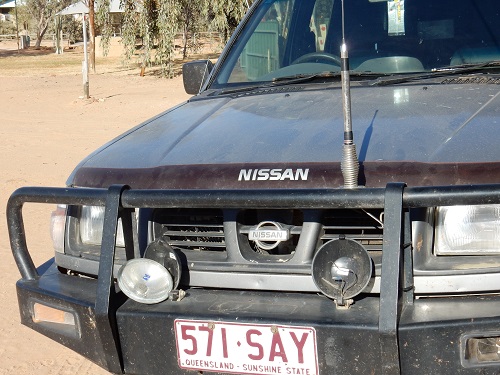
Other than the odd bit of wear and/or damage to the odd bush and bracket Bessie was found to be in fine shape when serviced back home in Emerald.
There are said to be some 1142 sand dunes in the Simpson Desert crossing, at least over 1100. In travel time that means almost one per minute across the whole distance. There were none on the first day to Purnie Bore and considerable time is spent travelling parallel to the dunes, so I think they count every hillock rather than just the major land forms. Here are a couple of landscapes from the French Line heading towards Poeppel Corner, showing the view from one sandhill to the next:
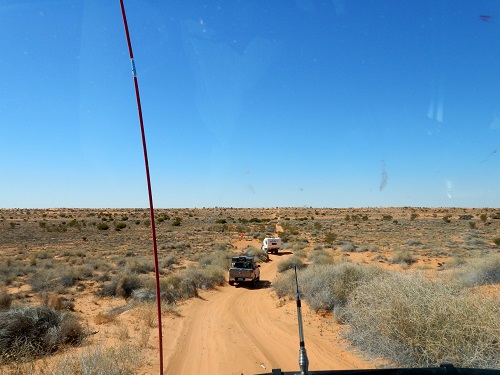
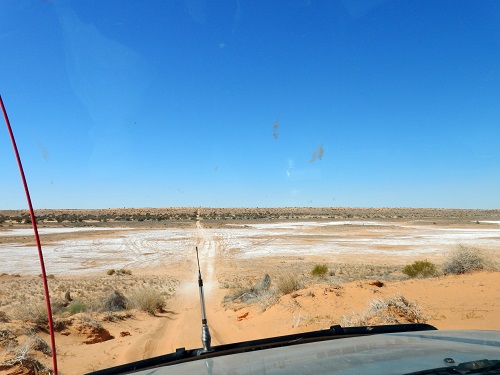
This is what a garden variety sandhill looks like up close:
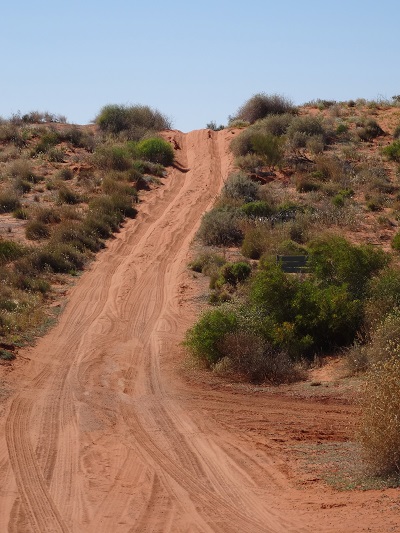
This particular dune had firm rather than powdery sand and the track is not badly scalloped, making the vehicle pitch and lurch. However, there is a steep pinch near the top and if you don’t attack the dune with enough momentum you can run out of power or spin near the top.
Here’s Ian stuck near the very top:
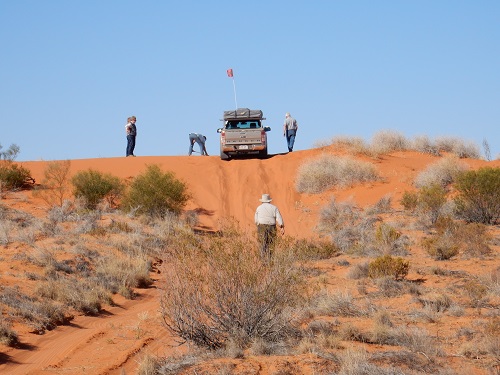
When he tried to back up to have another go the front wheels must have spun, so Don is scraping out a channel. We always filled in the holes we dug.
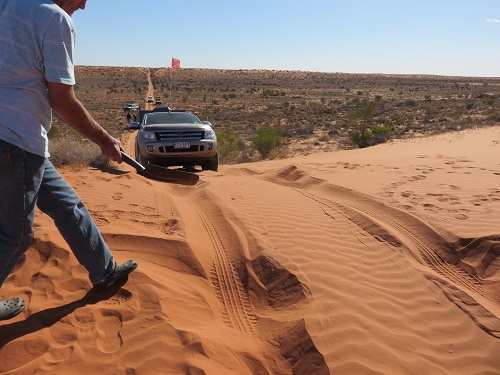
This performance was repeated a number of times.
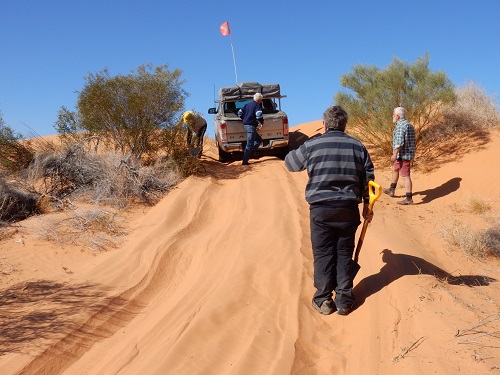
The vehicle had a fair bit of weight on the back and was fitted with highway tread on the tyres. Perhaps a combination of those factors caused the problem.
As recommended we all reduced the pressure in our tyres to maximise friction with the sand. Len had ours at 15 psi in the back and 13 in the front by the time we hit Big Red. Any lower and you risk a tyre coming off the rim. So an air compressor to re-inflate the tyres for the highway is standard kit.
This is what a sandhill looks like when approaching the top:
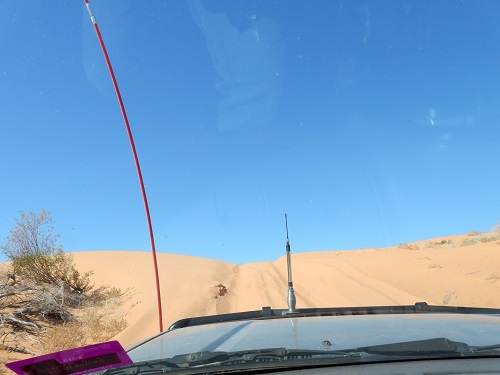
On the other side the track usually veered to the right, that’s if it didn’t veer left or go straight ahead, so quick reflexes were required.
Each vehicle must carry a red flag, 3.5 metres above the ground as seen here:
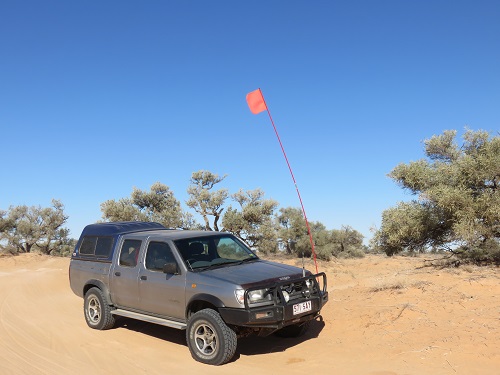
Trailing vehicles in a convoy can see which way the vehicle in front moves. Our leading vehicle was Don and Patsy in this magnificent machine, which sat up a bit in front:
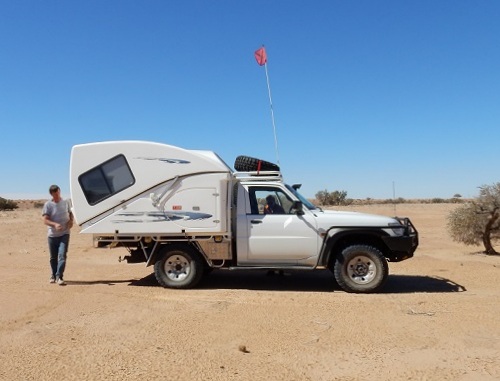
Dealing with the crests must have been a bit scary!
Another essential piece of kit is a UHF radio. We gave our position on Channel 10 every 10 minutes or so, but didn’t always hear from others. On two occasions the first awareness of oncoming vehicles was seeing a flag over the sandhill.
In general terms we negotiated the desert pretty well, and didn’t need maxitracks, winches or sand anchors. It seems to me that you would need to go out of your way to get in this kind of fix:
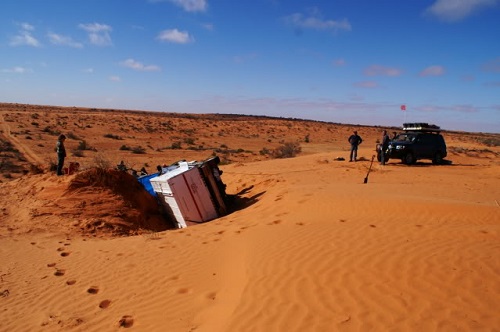
When we camped at Boulia on the way over, Margot overheard a camper telling his neighbour, “They’ll never make it!”
Well, old-timer, we made it just fine!
* Note: The number of 15 is from memory, but I can’t remember the source! This National Parks, South Australia site suggests more than 12,000 people in 2013, that would be about 33 people per day. I think the average people per vehicle is unlikely to be more than two.
Ian G-J was told at Mt Dare 30 at quieter times and 100 at busy times but he can’t remember whether that’s people or vehicles. I’d guess people – there weren’t many vehicles at all in the camping ground when we were there in early August. So there is a high degree of uncertainty but at least 15 vehicles per day on average.
Update: Here’s an image of the “The Monster”, the Birdsville Desert Recovery vehicle, with a 4WD on its back, supplied via a mate of Darral:
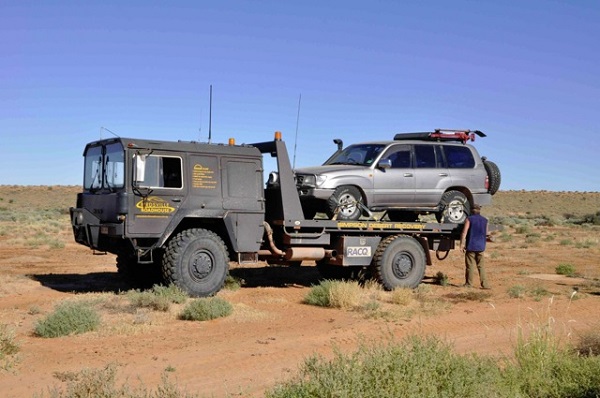

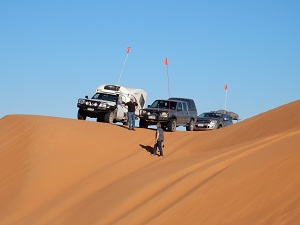
I would emphasise that 2 litres of water per day is very low for hot dry country. Dry can be very deceptive. You nay not feel hot but still go through water like it is going out of fashion. (On the other hand, most of my experience was walking so perhaps i am being conservative.)
John, all can say is that we didn’t deny ourselves drinking fluid. We did on two occasions use someone else’s washing up water after they had had a relatively clean wash. The weather was cool, for Brisbane people.
I’ve put a note at the end of the post about vehicle numbers. There is a high degree of uncertainty, but it looks like at least 15 vehicles per day on average, but could be more than double that.
Nice photos and your description of your trek across the desert! What wonderful memories you all share! Fantastic!
John & Doris
I’ve just added an update showing a photo of “The Monster”, the Birdsville Desert Recovery Service vehicle with a 4WD on its back.